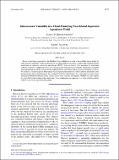| dc.contributor.author | Khairoutdinov, Marat F. | |
| dc.contributor.author | Emanuel, Kerry Andrew | |
| dc.date.accessioned | 2020-05-21T13:48:49Z | |
| dc.date.available | 2020-05-21T13:48:49Z | |
| dc.date.issued | 2018-12 | |
| dc.date.submitted | 2018-05 | |
| dc.identifier.issn | 1520-0469 | |
| dc.identifier.uri | https://hdl.handle.net/1721.1/125369 | |
| dc.description.abstract | Recent studies have suggested that the Madden-Julian oscillation is a result of an instability driven mainly by cloud-radiation feedbacks, similar in character to self-aggregation of convection in nonrotating, cloud-permitting simulations of radiative-convective equilibrium (RCE). Here we bolster that inference by simulating radiative-convective equilibrium states on a rotating sphere with constant sea surface temperature, using the cloud-permitting System for Atmospheric Modeling (SAM) with 20-km grid spacing and extending to walls at 46° latitude in each hemisphere. Mechanism-denial experiments reveal that cloud-radiation interaction is the quintessential driving mechanism of the simulated MJO-like disturbances, but wind-induced surface heat exchange (WISHE) feedbacks are the primary driver of its eastward propagation. WISHE may also explain the faster Kelvin-like modes in the simulations. These conclusions are supported by a linear stability analysis of RCE states on an equatorial beta plane. ©2018 American Meteorological Society. | en_US |
| dc.description.sponsorship | NSF Grant (AGS1418508) | en_US |
| dc.description.sponsorship | NSF Grant (AGS1418309) | en_US |
| dc.language.iso | en | |
| dc.publisher | American Meteorological Society | en_US |
| dc.relation.isversionof | 10.1175/JAS-D-18-0152.1 | en_US |
| dc.rights | Article is made available in accordance with the publisher's policy and may be subject to US copyright law. Please refer to the publisher's site for terms of use. | en_US |
| dc.source | American Meteorological Society | en_US |
| dc.title | Intraseasonal Variability in a Cloud-Permitting Near-Global Equatorial Aquaplanet Model | en_US |
| dc.type | Article | en_US |
| dc.identifier.citation | Khairoutdinov, Marat F. et. al., "Intraseasonal Variability in a Cloud-Permitting Near-Global Equatorial Aquaplanet Model." Journal of the Atmospheric Sciences 75, 12 (December 2018): 4337-55 doi. 10.1175/JAS-D-18-0152.1 ©2018 Authors | en_US |
| dc.contributor.department | Lorenz Center (Massachusetts Institute of Technology) | en_US |
| dc.relation.journal | Journal of the Atmospheric Sciences | en_US |
| dc.eprint.version | Final published version | en_US |
| dc.type.uri | http://purl.org/eprint/type/JournalArticle | en_US |
| eprint.status | http://purl.org/eprint/status/PeerReviewed | en_US |
| dc.date.updated | 2020-04-17T14:29:54Z | |
| dspace.date.submission | 2020-04-17T14:30:08Z | |
| mit.journal.volume | 75 | en_US |
| mit.journal.issue | 12 | en_US |
| mit.license | PUBLISHER_POLICY | |
| mit.metadata.status | Complete | |
